Raccoon Tracks and Sign
An Online Field Guide
Procyon lotor
Raccoon tracks can be found throughout the United States in almost all habitat types. They are a member of the Procyonidae family, which also includes the ringtail and coati. Raccoons are omnivorous, eating a wide range of foods from crayfish and frogs, to berries and eggs.
Raccoon Tracks
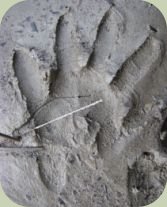
Tracks: Raccoon footprints are hand-shaped with a diameter that measures 2 to 3 inches across. They register five finger-like toes in both front and hind feet and also often register small claws. Their tracks are asymmetrical. The innermost toe is smallest and further towards the rear of the foot than the other toes, which allows left and right tracks to be differentiated. Their foot pad is roughly C-shaped. Front tracks have longer toes that are more spread apart. Hind feet often register a larger palm and heel pad. The photo to the right is a left front track. The photo below shows a left front track next to a right hind track.
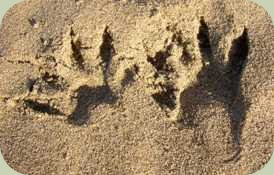
Gaits: Raccoons have a unique walking gait that they utilize when traveling and foraging. This unique walking gait results in a trail pattern where front and hind tracks from opposite sides of the body register next to each other, as in the photo below. Step lengths in this gait vary from 10 to 18 inches. Raccoons will also utilize lopes and gallops when avoiding danger.
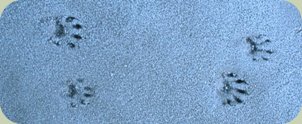
Raccoon Sign
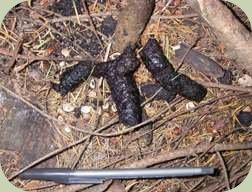
Scat: Because raccoons are omnivorous, their scat can be quite variable in color, consistency, and shape. It is often found at the base of trees which they climb and use for resting. When consuming drier foods, raccoon scat is tubular with blocky ends and a diameter of approximately 3/8 of an inch. Caution should be exercised around raccoon scat, as it can contain parasitic roundworms which, if inhaled, can cause serious harm to humans.
Be More Prepared For Your Next Outdoor Adventure!

Don't leave without knowing these six essential survival skills. Our free survival mini guide reveals the strategies of:
- Shelter & fire to prevent the number one cause of death
- Obtaining clean water to avoid life-threatening dehydration
- Common wild survival foods and other critical skills!

Similar Tracks: River otter and opossum tracks can be mistaken for raccoon footprints. River otter tracks have rounder toes and often show webbing between the toes. Also, river otters primarily lope rather than walk. Opossums have a very large thumb-like toe on the hind foot which helps identify them from other similar tracks.
Additional Resources:
Raccoon Sign & Tracks - Bear Tracker's Pages
References: Elbroch 2003, Halfpenny 1999, Murie 1954, Rezendes 1999.
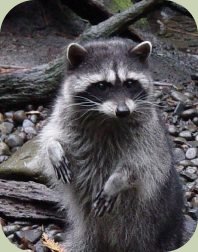
Raccoon in western Washington rainforest.
To learn more about animal tracks, check out our
Wildlife Tracking Courses
Additional Resources on Raccoons:
Here's an interesting website dedicated entirely to facts about raccoons: http://fohn.net/raccoon-pictures-facts/.
By the way, when you're out tracking or looking for wild animals, it's important to know how to stay safe in the outdoors, especially if you were to get lost. Right now you can get a free copy of our mini survival guide here, where you'll discover six key strategies for outdoor emergencies, plus often-overlooked survival tips.

About the Author: Jason Knight is a cofounder of Alderleaf Wilderness College and the author of The Essential Skills of Wilderness Survival. He has been teaching wilderness skills for over twenty-five years. Learn more about Jason Knight.
Return from Raccoon Tracks back to Animal Tracking Articles
Is The Essential Wilderness Survival Skills Course Right for You? Take the "Online Survival Training Readiness" Quiz
See for yourself if this eye-opening course is a good fit for you. It takes just a few minutes! Get your Survival Training Readiness Score Now!

Grow Your Outdoor Skills! Get monthly updates on new wilderness skills, upcoming courses, and special opportunities. Join the free Alderleaf eNews and as a welcome gift you'll get a copy of our Mini Survival Guide.

 The Six Keys to Survival: Get a free copy of our survival mini-guide and monthly tips!
The Six Keys to Survival: Get a free copy of our survival mini-guide and monthly tips!
Learn more